印度种姓制度英文介绍
- 格式:docx
- 大小:32.34 KB
- 文档页数:25
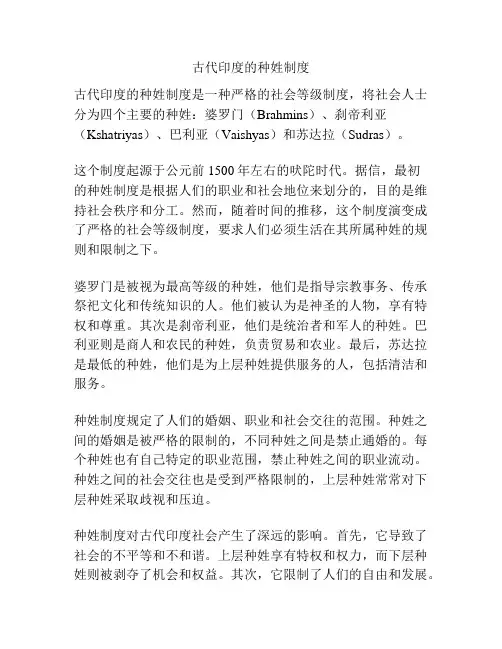
古代印度的种姓制度古代印度的种姓制度是一种严格的社会等级制度,将社会人士分为四个主要的种姓:婆罗门(Brahmins)、刹帝利亚(Kshatriyas)、巴利亚(Vaishyas)和苏达拉(Sudras)。
这个制度起源于公元前1500年左右的吠陀时代。
据信,最初的种姓制度是根据人们的职业和社会地位来划分的,目的是维持社会秩序和分工。
然而,随着时间的推移,这个制度演变成了严格的社会等级制度,要求人们必须生活在其所属种姓的规则和限制之下。
婆罗门是被视为最高等级的种姓,他们是指导宗教事务、传承祭祀文化和传统知识的人。
他们被认为是神圣的人物,享有特权和尊重。
其次是刹帝利亚,他们是统治者和军人的种姓。
巴利亚则是商人和农民的种姓,负责贸易和农业。
最后,苏达拉是最低的种姓,他们是为上层种姓提供服务的人,包括清洁和服务。
种姓制度规定了人们的婚姻、职业和社会交往的范围。
种姓之间的婚姻是被严格的限制的,不同种姓之间是禁止通婚的。
每个种姓也有自己特定的职业范围,禁止种姓之间的职业流动。
种姓之间的社会交往也是受到严格限制的,上层种姓常常对下层种姓采取歧视和压迫。
种姓制度对古代印度社会产生了深远的影响。
首先,它导致了社会的不平等和不和谐。
上层种姓享有特权和权力,而下层种姓则被剥夺了机会和权益。
其次,它限制了人们的自由和发展。
由于种姓之间的职业流动和婚姻是受到限制的,许多人无法从事他们喜欢的工作或嫁娶他们所爱的人。
此外,种姓制度也阻碍了社会的进步和改革,因为任何的改变都会受到强大的传统和种姓利益集团的阻碍。
尽管种姓制度在印度的现代社会已经大大减弱,但残留的不平等和歧视问题仍然存在。
政府和民间组织一直在努力推动社会公正和平等的议程,但要完全消除种姓差别仍然面临诸多困难。
种姓制度的长期存在和深远影响已成为印度历史和文化的重要组成部分。
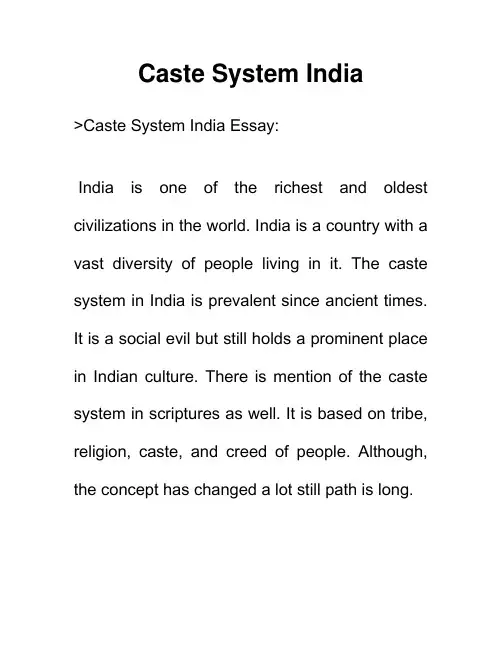
Caste System India>Caste System India Essay:India is one of the richest and oldest civilizations in the world. India is a country with a vast diversity of people living in it. The caste system in India is prevalent since ancient times. It is a social evil but still holds a prominent place in Indian culture. There is mention of the caste system in scriptures as well. It is based on tribe, religion, caste, and creed of people. Although, the concept has changed a lot still path is long.Long and Short Essays on Caste System in India for Students and Kids in EnglishGiven below is a long essay composed of about 500 words and a short composition comprising 100-150 words on the caste system in English.Long Essay on Caste System India 500 Words in EnglishCaste System India Essay is usually given to classes 7, 8, 9, and 10.India is a country that is socially and politically stratified. The caste system in Indian culture isprevailing for ages. The people in the Indian society are divided based on their caste or jobs they do is called the caste system in India. From ancient times, there are four classes of people in Indian society, namely, Brahmans, Kshatriyas, Vaishya, and Shudra. There are many stories about how the caste system originated. Some are historical while some are religious and biological.According to Rig Veda, the human was formed by, “Purush” by destroying himself. The head was made Brahmans, hands were transformed to Kshatriyas, Vaishyas from thighs, andShudras from feet. But apart from these four there was one more caste. The brief about them is as follows:Brahmins:They were considered to be of the highest order in society. They acted as guardians of the religion. They were highly respected and usually perform jobs of teachers, priests, and other respectable jobs.Kshatriyas:They were placed in second-order after brahmins. They were assigned jobs of warriors or landlords in society. They were well-known for their bravery and courage.Vaishya:They were people involved in the business. They were merchants, goldsmiths, small traders, and others. They were suppliers of essential commodities in society.Shudra:They were the people who did menial jobs like laborers, artisans, craftsmen, and others. They were not allowed any formal education of Vedas and were last in order.Dalits:They were the people engaged in jobs like sweepers, shoemakers, washers, and others. They were also untouchables and were not even treated like humans. The caste system had a lot of negative impacts. It deprived the citizens of their rights. It hindered their choice of job and education. There were cases of forced conversion of caste and even killings. It dividedand distributed the harmony and unity of society. It leads to an inferiority complex among the people of the lower caste. It is a social evil that exploited growth. It has been a cause of constant distress in society.With the growth of education, science, and technology in India, people are now aware of this evil. With the spread of modernization and urbanization, the effect of the caste system has decreased drastically. With the enhancement of education and efforts of the government, the deep-rooted effect of the caste system is now diminishing to a great extent. Many laws, acts,and bans are being formed by the government for the abolishment of the caste system.Even after consistent efforts from the government and even citizens, there still is a caste system prevailing in Indian society. The effect is more visible in urban areas as compared to rural areas. The thing to understand here is, until the people understand that this caste system is beneficial for only a few opportunists but not for all, it is hard to end it. Once this is realized, it will welcome true freedom.Short Essay on Caste System in India 500 Words in EnglishCaste System India essay is usually provided to classes 1, 2, 3, 4, 5, and 6.India is a country with unity in >Biodiversity. The caste system is prevailing in India from ancient times. Even after so much advancement, the caste system is still prevailing in India to some extent. Originally, the caste was based on the job performed by the individual. There were basically four different castes, namely:Brahmins:Priests, Teachers, and Scholars Kshatriyas:Rulers and WarriorsVaishyas:Farmers, Merchants, and Traders Shudras:LabourersUntouchables or Dalits:sweepers, shoemakers, washers, and others The caste system has many negative impacts on the growth of society. It stopped people from availing of their rights. It leads to widespread discrimination and the feeling of inferiority complex among people of the lower caste. They were even deprived of their basic rights of food, cloth, and even to follow a god. It infuses false pride in the people of the upper class as well. This leads to the growth of the silent feeling of hatred among the communities.The government is trying hard by forming acts and laws to ban the caste system. With theadvent of modernization and education, it has reduced. The caste system needs to be eliminated to enjoy equality and peace. The true fragrance of democracy can be experienced only when there is equality and no discrimination.10 Lines on Caste System India Essay in EnglishIndia is a country with one of the oldest cultures.Historically, the caste system is based on the jobs adopted by the person based on birth.Mainly, there are four castes: Brahmans, Kshatriyas, Vaishya, and Shudra. There is a fifth class called Dalits.Priests, teachers, and scholars come under brahmins who top the hierarchy. Next in line is Kshatriyas who are warriors and landlords. Followed by them are Vaishyas who are business class and the next are Shudras who do menial work. The last is Dalits or untouchables who perform sweeping, washing, and petty jobs.The caste system is a social evil that has been prevailing in Indian society for long.It leads to discrimination and hampers harmony.The government has formulated various acts and laws to stop this practice.As the people gained education and knowledge about their rights, the effect of the caste system reduced.Awareness among people about their rights has been a great help in reducing discrimination.To enjoy true freedom, it is our duty as a citizen to stop discrimination based on caste and make people aware of the same.FAQ’s on Caste System Indi a EssayQuestion 1.What is caste system?Answer:The caste system in India is prevailing since ancient times. It is the classification of the people based on the jobs performed by them.Question 2.What are the different castes under the caste system?Answer:There are mainly four castes under the caste system. Additionally, one more caste was added. They are:Brahmins: Priests, Teachers, and ScholarsKshatriyas: Rulers and WarriorsVaishyas: Farmers, Merchants, and TradersShudras: LabourersUntouchables or Dalits: sweepers, shoemakers, washers, and others Question 3.Discuss any one problem of the caste system.Answer:The most common problem of the caste system is inequality. It leads to a feeling of hatred among different communities.Question 4.How does caste system impact society?Answer:The caste system is a social evil that has negatively impacted society. To enjoy the truebenefit of democracy, the caste system needs to be abolished from society.。
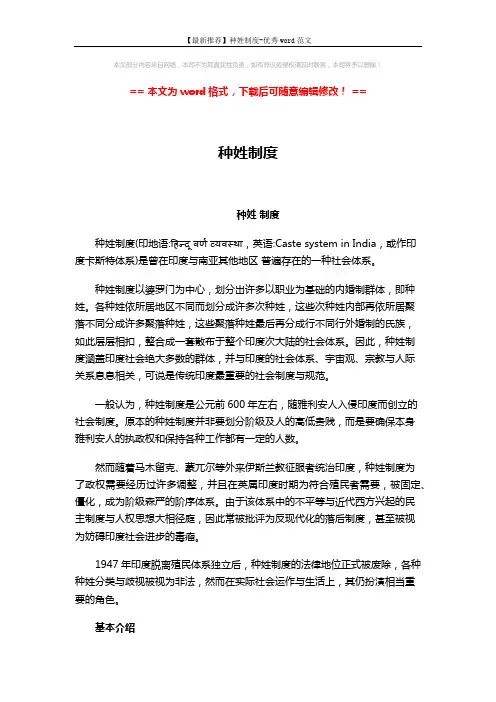
【最新推荐】种姓制度-优秀word范文
本文部分内容来自网络,本司不为其真实性负责,如有异议或侵权请及时联系,本司将予以删除!
== 本文为word格式,下载后可随意编辑修改! ==
种姓制度
种姓制度
种姓制度(印地语:,英语:Caste system in India,或作印度卡斯特体系)是曾在印度与南亚其他地区普遍存在的一种社会体系。
种姓制度以婆罗门为中心,划分出许多以职业为基础的内婚制群体,即种姓。
各种姓依所居地区不同而划分成许多次种姓,这些次种姓内部再依所居聚
落不同分成许多聚落种姓,这些聚落种姓最后再分成行不同行外婚制的氏族,
如此层层相扣,整合成一套散布于整个印度次大陆的社会体系。
因此,种姓制
度涵盖印度社会绝大多数的群体,并与印度的社会体系、宇宙观、宗教与人际
关系息息相关,可说是传统印度最重要的社会制度与规范。
一般认为,种姓制度是公元前600年左右,随雅利安人入侵印度而创立的社会制度。
原本的种姓制度并非要划分阶级及人的高低贵贱,而是要确保本身
雅利安人的执政权和保持各种工作都有一定的人数。
然而随着马木留克、蒙兀尔等外来伊斯兰教征服者统治印度,种姓制度为
了政权需要经历过许多调整,并且在英属印度时期为符合殖民者需要,被固定、僵化,成为阶级森严的阶序体系。
由于该体系中的不平等与近代西方兴起的民
主制度与人权思想大相径庭,因此常被批评为反现代化的落后制度,甚至被视
为妨碍印度社会进步的毒瘤。
1947年印度脱离殖民体系独立后,种姓制度的法律地位正式被废除,各种种姓分类与歧视被视为非法,然而在实际社会运作与生活上,其仍扮演相当重
要的角色。
基本介绍。
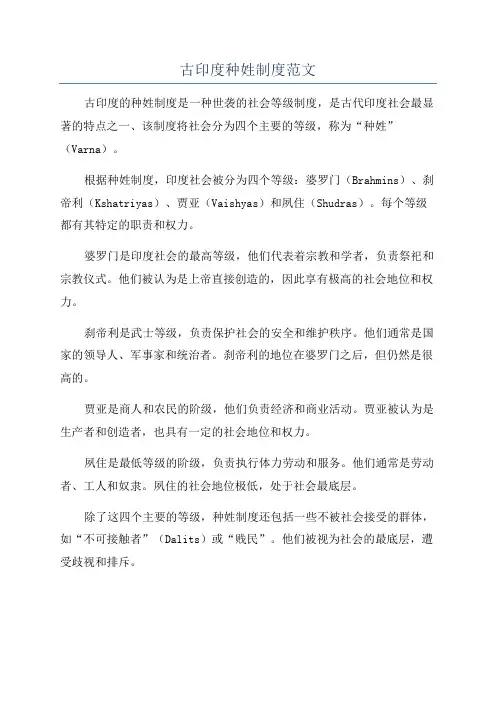
古印度种姓制度范文古印度的种姓制度是一种世袭的社会等级制度,是古代印度社会最显著的特点之一、该制度将社会分为四个主要的等级,称为“种姓”(Varna)。
根据种姓制度,印度社会被分为四个等级:婆罗门(Brahmins)、刹帝利(Kshatriyas)、贾亚(Vaishyas)和夙住(Shudras)。
每个等级都有其特定的职责和权力。
婆罗门是印度社会的最高等级,他们代表着宗教和学者,负责祭祀和宗教仪式。
他们被认为是上帝直接创造的,因此享有极高的社会地位和权力。
刹帝利是武士等级,负责保护社会的安全和维护秩序。
他们通常是国家的领导人、军事家和统治者。
刹帝利的地位在婆罗门之后,但仍然是很高的。
贾亚是商人和农民的阶级,他们负责经济和商业活动。
贾亚被认为是生产者和创造者,也具有一定的社会地位和权力。
夙住是最低等级的阶级,负责执行体力劳动和服务。
他们通常是劳动者、工人和奴隶。
夙住的社会地位极低,处于社会最底层。
除了这四个主要的等级,种姓制度还包括一些不被社会接受的群体,如“不可接触者”(Dalits)或“贱民”。
他们被视为社会的最底层,遭受歧视和排斥。
种姓制度对古印度社会产生了深远的影响。
首先,它决定了每个人的职业和社会地位,并给予不同种姓以不同的权力和特权。
这造成了社会的不平等和分裂。
其次,种姓制度对印度宗教和文化产生了重大影响。
婆罗门等级的人拥有宗教权力,掌握着印度教的解释权。
他们通过宗教仪式和教导来维护自己的地位和权力。
最后,种姓制度给予了少数人各种社会经济特权,而剥夺了其他人的权利和机会。
这导致社会不公平和不稳定,也是印度历史上许多社会和政治问题的根源。
然而,随着时间的推移,种姓制度逐渐减弱,尤其是在现代印度。
1947年印度独立后,成立了一个新的宪法,禁止对贱民的歧视,并推动社会平等和正义。
总的来说,古印度的种姓制度是一种世袭的社会等级制度,将社会分为不同的等级和职责。
尽管它对印度社会产生了深远的影响,但现代印度正努力消除种姓歧视,实现社会的平等和公正。
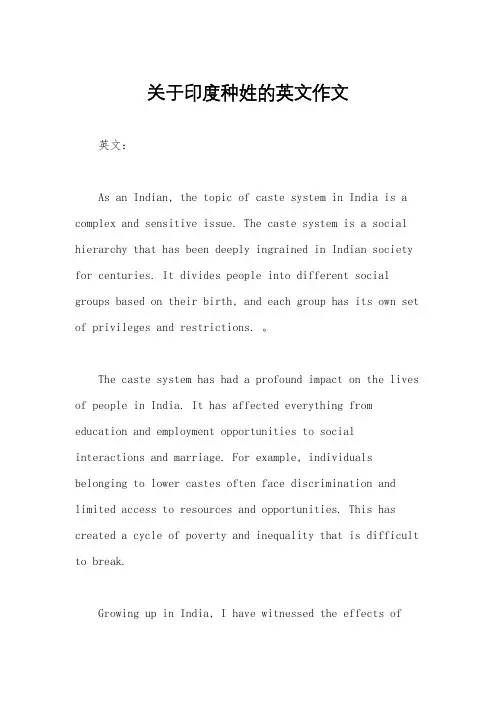
关于印度种姓的英文作文英文:As an Indian, the topic of caste system in India is a complex and sensitive issue. The caste system is a social hierarchy that has been deeply ingrained in Indian society for centuries. It divides people into different social groups based on their birth, and each group has its own set of privileges and restrictions. 。
The caste system has had a profound impact on the lives of people in India. It has affected everything from education and employment opportunities to social interactions and marriage. For example, individuals belonging to lower castes often face discrimination and limited access to resources and opportunities. This has created a cycle of poverty and inequality that is difficult to break.Growing up in India, I have witnessed the effects ofthe caste system firsthand. I have seen how people from lower castes are often marginalized and denied the same opportunities as those from higher castes. This has led to a deep sense of injustice and inequality among many people in India.中文:作为印度人,种姓制度是一个复杂而敏感的问题。
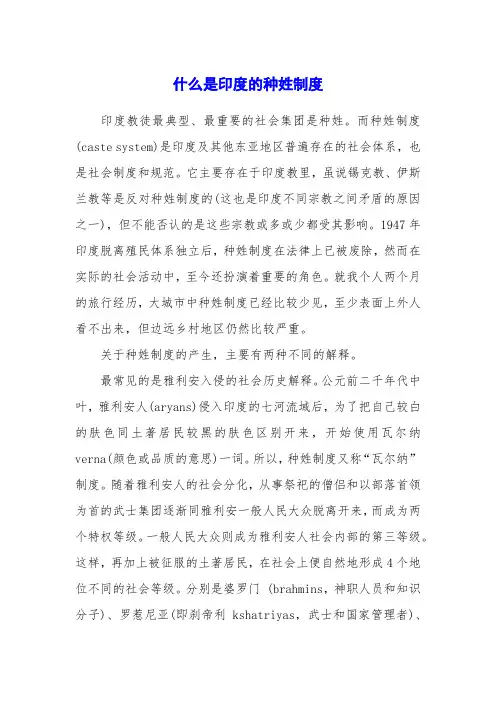
什么是印度的种姓制度印度教徒最典型、最重要的社会集团是种姓。
而种姓制度(caste system)是印度及其他东亚地区普遍存在的社会体系,也是社会制度和规范。
它主要存在于印度教里,虽说锡克教、伊斯兰教等是反对种姓制度的(这也是印度不同宗教之间矛盾的原因之一),但不能否认的是这些宗教或多或少都受其影响。
1947年印度脱离殖民体系独立后,种姓制度在法律上已被废除,然而在实际的社会活动中,至今还扮演着重要的角色。
就我个人两个月的旅行经历,大城市中种姓制度已经比较少见,至少表面上外人看不出来,但边远乡村地区仍然比较严重。
关于种姓制度的产生,主要有两种不同的解释。
最常见的是雅利安入侵的社会历史解释。
公元前二千年代中叶,雅利安人(aryans)侵入印度的七河流域后,为了把自己较白的肤色同土著居民较黑的肤色区别开来,开始使用瓦尔纳verna(颜色或品质的意思)一词。
所以,种姓制度又称“瓦尔纳”制度。
随着雅利安人的社会分化,从事祭祀的僧侣和以部落首领为首的武士集团逐渐同雅利安一般人民大众脱离开来,而成为两个特权等级。
一般人民大众则成为雅利安人社会内部的第三等级。
这样,再加上被征服的土著居民,在社会上便自然地形成4个地位不同的社会等级。
分别是婆罗门 (brahmins,神职人员和知识分子)、罗惹尼亚(即刹帝利kshatriyas,武士和国家管理者)、吠舍(vaishyas,工商业者)和首陀罗 (shudras,工匠和奴隶)。
波罗门和刹帝利这两个高级种姓,占有了古代印度社会中的大部分财富,依靠剥削为生,是社会中的统治阶级。
吠舍是古代印度社会中的普通劳动者,也就是雅利安人的中下阶层,包括农民、手工业者和商人,他们必须向国家缴纳赋税。
首陀罗是指那些失去土地的自由民和被征服的达罗毗荼人,实际上处于奴隶的地位。
根据印度教《摩奴法典》规定,各个种姓职业世袭,互不通婚,以保持严格的界限。
如果违反规定, 就会受到处罚。
由于印度教重男轻女, 在婚姻制度上也对男子网开一面, 允许高种姓的男子娶比自己低一个种姓的女子为妻,这种情况称为“顺婚”, 虽不鼓励,但可以容忍。
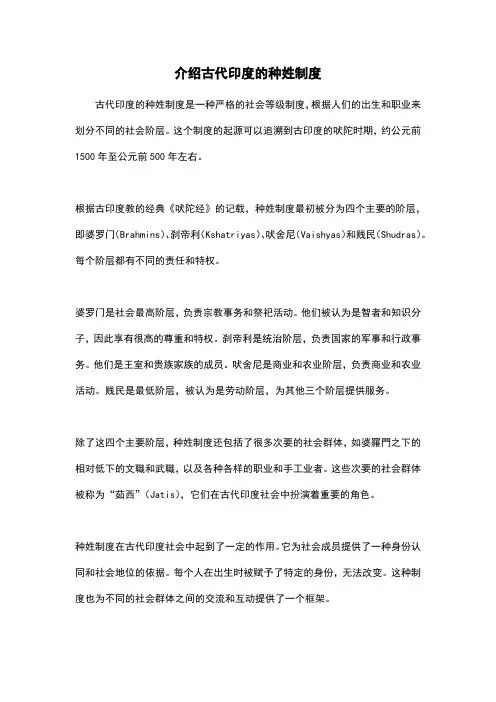
介绍古代印度的种姓制度古代印度的种姓制度是一种严格的社会等级制度,根据人们的出生和职业来划分不同的社会阶层。
这个制度的起源可以追溯到古印度的吠陀时期,约公元前1500年至公元前500年左右。
根据古印度教的经典《吠陀经》的记载,种姓制度最初被分为四个主要的阶层,即婆罗门(Brahmins)、刹帝利(Kshatriyas)、吠舍尼(Vaishyas)和贱民(Shudras)。
每个阶层都有不同的责任和特权。
婆罗门是社会最高阶层,负责宗教事务和祭祀活动。
他们被认为是智者和知识分子,因此享有很高的尊重和特权。
刹帝利是统治阶层,负责国家的军事和行政事务。
他们是王室和贵族家族的成员。
吠舍尼是商业和农业阶层,负责商业和农业活动。
贱民是最低阶层,被认为是劳动阶层,为其他三个阶层提供服务。
除了这四个主要阶层,种姓制度还包括了很多次要的社会群体,如婆羅門之下的相对低下的文職和武職,以及各种各样的职业和手工业者。
这些次要的社会群体被称为“茹西”(Jatis),它们在古代印度社会中扮演着重要的角色。
种姓制度在古代印度社会中起到了一定的作用。
它为社会成员提供了一种身份认同和社会地位的依据。
每个人在出生时被赋予了特定的身份,无法改变。
这种制度也为不同的社会群体之间的交流和互动提供了一个框架。
然而,种姓制度也存在一些问题和不公平之处。
一方面,它限制了社会流动性,使得人们无法改变自己的社会地位。
另一方面,种姓制度导致了社会不平等和歧视。
贱民和次要种姓群体常常受到歧视和剥削,他们被排除在社会主流之外。
在现代印度,种姓制度仍然存在,但被法律禁止歧视和剥削。
印度政府实施了各种措施来提高贱民和其他弱势群体的社会地位和福利。
尽管如此,种姓问题仍然是印度社会中一个重要的议题,并需要长期的努力来实现社会的公正和平等。
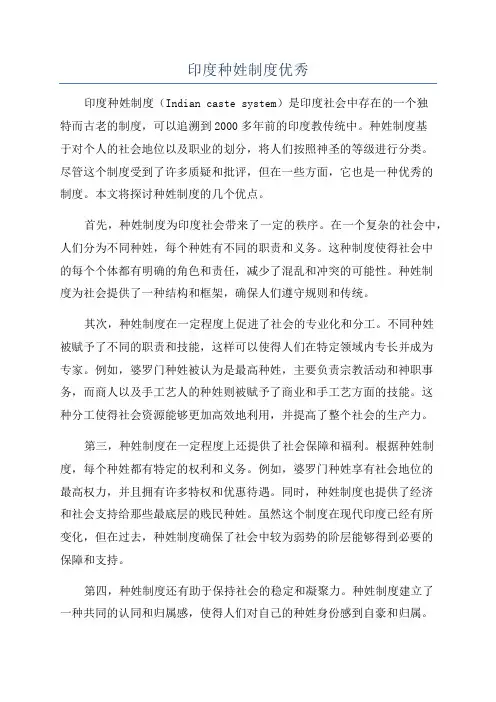
印度种姓制度优秀印度种姓制度(Indian caste system)是印度社会中存在的一个独特而古老的制度,可以追溯到2000多年前的印度教传统中。
种姓制度基于对个人的社会地位以及职业的划分,将人们按照神圣的等级进行分类。
尽管这个制度受到了许多质疑和批评,但在一些方面,它也是一种优秀的制度。
本文将探讨种姓制度的几个优点。
首先,种姓制度为印度社会带来了一定的秩序。
在一个复杂的社会中,人们分为不同种姓,每个种姓有不同的职责和义务。
这种制度使得社会中的每个个体都有明确的角色和责任,减少了混乱和冲突的可能性。
种姓制度为社会提供了一种结构和框架,确保人们遵守规则和传统。
其次,种姓制度在一定程度上促进了社会的专业化和分工。
不同种姓被赋予了不同的职责和技能,这样可以使得人们在特定领域内专长并成为专家。
例如,婆罗门种姓被认为是最高种姓,主要负责宗教活动和神职事务,而商人以及手工艺人的种姓则被赋予了商业和手工艺方面的技能。
这种分工使得社会资源能够更加高效地利用,并提高了整个社会的生产力。
第三,种姓制度在一定程度上还提供了社会保障和福利。
根据种姓制度,每个种姓都有特定的权利和义务。
例如,婆罗门种姓享有社会地位的最高权力,并且拥有许多特权和优惠待遇。
同时,种姓制度也提供了经济和社会支持给那些最底层的贱民种姓。
虽然这个制度在现代印度已经有所变化,但在过去,种姓制度确保了社会中较为弱势的阶层能够得到必要的保障和支持。
第四,种姓制度还有助于保持社会的稳定和凝聚力。
种姓制度建立了一种共同的认同和归属感,使得人们对自己的种姓身份感到自豪和归属。
这种归属感有助于人们建立紧密的社区和群体,提高社会凝聚力。
种姓制度还通过限制婚姻和社交交往范围,保持了族群之间的纯洁性,确保了种姓的维持和传承。
尽管种姓制度有一些优点,但它也存在一些负面影响和问题。
例如,种姓制度造成了社会中的不平等和歧视。
较低种姓的人往往面临着社会排斥、机会限制和歧视待遇。
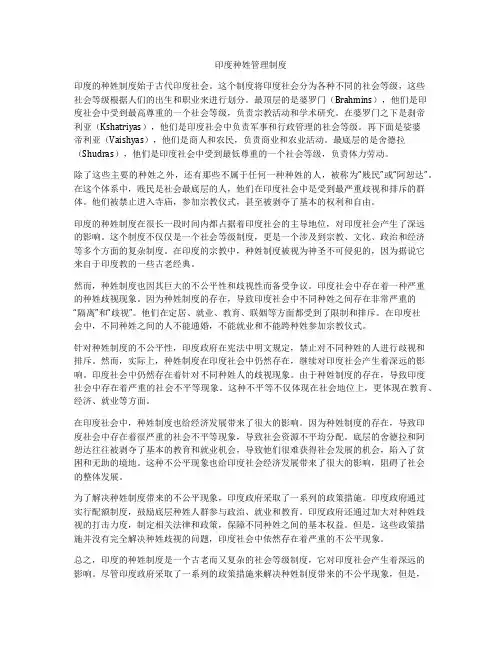
印度种姓管理制度印度的种姓制度始于古代印度社会。
这个制度将印度社会分为各种不同的社会等级,这些社会等级根据人们的出生和职业来进行划分。
最顶层的是婆罗门(Brahmins),他们是印度社会中受到最高尊重的一个社会等级,负责宗教活动和学术研究。
在婆罗门之下是刹帝利亚(Kshatriyas),他们是印度社会中负责军事和行政管理的社会等级。
再下面是娑婆帝利亚(Vaishyas),他们是商人和农民,负责商业和农业活动。
最底层的是舍德拉(Shudras),他们是印度社会中受到最低尊重的一个社会等级,负责体力劳动。
除了这些主要的种姓之外,还有那些不属于任何一种种姓的人,被称为“贱民”或“阿恕达”。
在这个体系中,贱民是社会最底层的人,他们在印度社会中是受到最严重歧视和排斥的群体。
他们被禁止进入寺庙,参加宗教仪式,甚至被剥夺了基本的权利和自由。
印度的种姓制度在很长一段时间内都占据着印度社会的主导地位,对印度社会产生了深远的影响。
这个制度不仅仅是一个社会等级制度,更是一个涉及到宗教、文化、政治和经济等多个方面的复杂制度。
在印度的宗教中,种姓制度被视为神圣不可侵犯的,因为据说它来自于印度教的一些古老经典。
然而,种姓制度也因其巨大的不公平性和歧视性而备受争议。
印度社会中存在着一种严重的种姓歧视现象。
因为种姓制度的存在,导致印度社会中不同种姓之间存在非常严重的“隔离”和“歧视”。
他们在定居、就业、教育、联姻等方面都受到了限制和排斥。
在印度社会中,不同种姓之间的人不能通婚,不能就业和不能跨种姓参加宗教仪式。
针对种姓制度的不公平性,印度政府在宪法中明文规定,禁止对不同种姓的人进行歧视和排斥。
然而,实际上,种姓制度在印度社会中仍然存在,继续对印度社会产生着深远的影响。
印度社会中仍然存在着针对不同种姓人的歧视现象。
由于种姓制度的存在,导致印度社会中存在着严重的社会不平等现象。
这种不平等不仅体现在社会地位上,更体现在教育、经济、就业等方面。
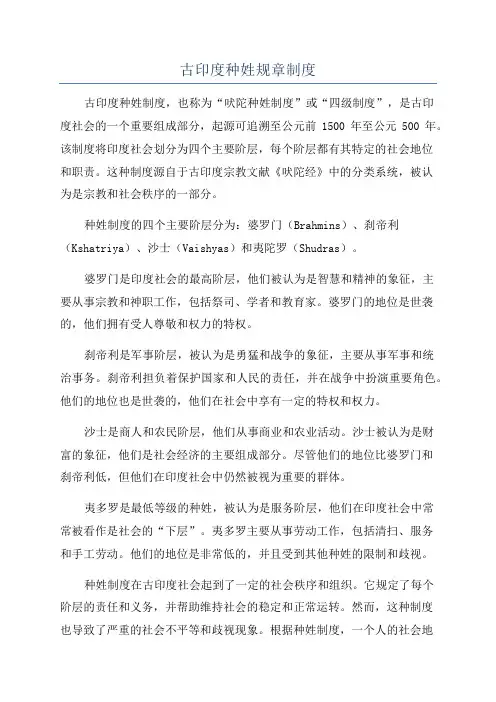
古印度种姓规章制度古印度种姓制度,也称为“吠陀种姓制度”或“四级制度”,是古印度社会的一个重要组成部分,起源可追溯至公元前1500年至公元500年。
该制度将印度社会划分为四个主要阶层,每个阶层都有其特定的社会地位和职责。
这种制度源自于古印度宗教文献《吠陀经》中的分类系统,被认为是宗教和社会秩序的一部分。
种姓制度的四个主要阶层分为:婆罗门(Brahmins)、刹帝利(Kshatriya)、沙士(Vaishyas)和夷陀罗(Shudras)。
婆罗门是印度社会的最高阶层,他们被认为是智慧和精神的象征,主要从事宗教和神职工作,包括祭司、学者和教育家。
婆罗门的地位是世袭的,他们拥有受人尊敬和权力的特权。
刹帝利是军事阶层,被认为是勇猛和战争的象征,主要从事军事和统治事务。
刹帝利担负着保护国家和人民的责任,并在战争中扮演重要角色。
他们的地位也是世袭的,他们在社会中享有一定的特权和权力。
沙士是商人和农民阶层,他们从事商业和农业活动。
沙士被认为是财富的象征,他们是社会经济的主要组成部分。
尽管他们的地位比婆罗门和刹帝利低,但他们在印度社会中仍然被视为重要的群体。
夷多罗是最低等级的种姓,被认为是服务阶层,他们在印度社会中常常被看作是社会的“下层”。
夷多罗主要从事劳动工作,包括清扫、服务和手工劳动。
他们的地位是非常低的,并且受到其他种姓的限制和歧视。
种姓制度在古印度社会起到了一定的社会秩序和组织。
它规定了每个阶层的责任和义务,并帮助维持社会的稳定和正常运转。
然而,这种制度也导致了严重的社会不平等和歧视现象。
根据种姓制度,一个人的社会地位和机会基本上是由出生决定的,这限制了个人的成长和发展。
低种姓人士长期以来受到高种姓人士的压迫和歧视,导致印度社会存在着严重的社会不平等和冲突。
然而,随着时间的推移,种姓制度的影响逐渐减弱,社会变得越来越开放和包容。
印度宪法废除了对夷多罗的歧视,并承认每个人都享有平等的权利和机会。
今天的印度社会中,种姓制度仍然存在一定的影响,但其重要性已大大减少。
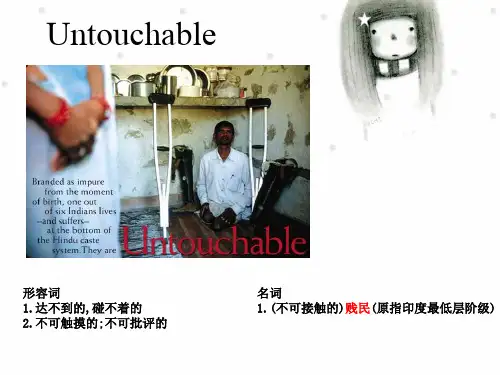
什么是印度的种姓制度文档2篇What is the caste system document in India什么是印度的种姓制度文档2篇小泰温馨提示:规章制度是指用人单位制定的组织劳动过程和进行劳动管理的规则和制度的总和。
本文档根据规则制度书写要求展开说明,具有实践指导意义,便于学习和使用,本文下载后内容可随意修改调整修改及打印。
本文简要目录如下:【下载该文档后使用Word打开,按住键盘Ctrl键且鼠标单击目录内容即可跳转到对应篇章】1、篇章1:什么是印度的种姓制度文档2、篇章2:印度种姓制度解读文档篇章1:什么是印度的种姓制度文档印度教徒最典型、最重要的社会集团是种姓。
而种姓制度(caste system)是印度及其他东亚地区普遍存在的社会体系,也是社会制度和规范。
它主要存在于印度教里,虽说锡克教、伊斯兰教等是反对种姓制度的(这也是印度不同宗教之间矛盾的原因之一),但不能否认的是这些宗教或多或少都受其影响。
1947年印度脱离殖民体系独立后,种姓制度在法律上已被废除,然而在实际的社会活动中,至今还扮演着重要的角色。
就我个人两个月的旅行经历,大城市中种姓制度已经比较少见,至少表面上外人看不出来,但边远乡村地区仍然比较严重。
关于种姓制度的产生,主要有两种不同的解释。
最常见的是雅利安入侵的社会历史解释。
公元前二千年代中叶,雅利安人(aryans)侵入印度的七河流域后,为了把自己较白的肤色同土著居民较黑的肤色区别开来,开始使用瓦尔纳verna(颜色或品质的意思)一词。
所以,种姓制度又称“瓦尔纳”制度。
随着雅利安人的社会分化,从事祭祀的僧侣和以部落首领为首的武士集团逐渐同雅利安一般人民大众脱离开来,而成为两个特权等级。
一般人民大众则成为雅利安人社会内部的第三等级。
这样,再加上被征服的土著居民,在社会上便自然地形成4个地位不同的社会等级。
分别是婆罗门(brahmins,神职人员和知识分子)、罗惹尼亚(即刹帝利kshatriyas,武士和国家管理者)、吠舍(vaishyas,工商业者)和首陀罗(shudras,工匠和奴隶)。
印度种姓制度英文介绍篇一:印度种姓制度,What Is The Future ofThe Dalit——Caste System in IndiaOutlineTopic: What Is The Future of The Dalit in IndiaThesis statement:The status quo of the untouchables won 't change on account of the powerfulness of the religion, the unfavorableness of politics and the public ironclad values.Body part:1. Due to Hinduism, the Indian caste system still indicates the non-Dalits.2. Non-Dalits are in charge of the politic and the national economy.3. Due to Hinduism, the Dalits are subjected to the doom.4. Dalits have far less power in political and economic influence.Conclusion:Due to Hinduism, both Dalits and non-Dalits accept and believe the caste.Their ironclad values are difficult to change. While the non-Dalits are much powerful in politic and economy, the Dalits are subjected to the discrimination and lack economic and political basic to resist the caste. Therefore, Dalits have few chances of getting their status quo better.What Is The Future of The Dalit in India——Caste System in IndiaAs it has been reported on April 20th in News Weekly in America that Mayawati, who was born as the untouchable in India, is famous as “ Queen of the Dalit ” for her goal to be thechairman of the country and her ambition to make a difference to the untouchables. She is given support from quite a number of people especially the untouchables. Some believe that the poor condition of the untouchables is to change. However, as far as I ' m concerned, the status quo of the untouchables won ' t change on account of the powerfulness of the religion, the unfavorableness of politics and the public ironclad values.Of more importance, the Indian caste system still indicates the public behavior.On the one hand, those of higher caste still believe they are nolber.People may argue that the Indian Caste System has been shocked by modern civilization, its social funtion should have been curtailed. In law the caste has been abolished, however, the government is still in charge of those come from the highest Hindu caste.It has been estimated that about 82 percent of the Indians believe Hinduism.Different from other religions, Hinduism has a belief that people are borned into four major varnases: Brahman, Kshatriya, Vaishya, Shudra with an remaining of the Dalit,namely the untouchables. In the eyes of the Hinduists, there exist lowliness and nobleness among human kind. Their jobs are predeterminate and it 's difficult to change. Besides, they are required not to marry with people belong to other varnases especially the untouchable. As the most noble varnas, Brahman embraces the most authority and power while the untouchables encounter discrimination.“ Recordedfrom those who come from higher varnases: no matter how much you pay they won 't sweep for you because it' s job of the Dalit; even some of them would beg in the street rather than get a job of cleaning for it 's a jobdone by theuntouchable; a master, though has been educated in America which proclaims freedom, won ' t hire a Dalit as a chef however skillful the Dalit is …”Based on a local research, all matrimonial notices won 't miss one prerequisite: “belongto the same caste ”Q.uoted from a undergraduate of higher caste, he ,though disapproves the Indian Caste System, will never marry to a lady belonging to lower caste.Besides, they are not educated to oppose the caste. According to survey papers conducted by the United Nations Children's Fund, the Dalit suffer great inequality and discrimination in several provinces like Rajasthan andBihar. At the moment of lunch at school, children of Dalit can only line up at the back row, as a result, there is very little left for them to eat. What's worse, their teacher asks them to sit on the floor at the back of the classroom without any pity on them.All of the phenomenon mentioned above prove that caste has been deeply rooted in the non-Dalit 's mind that they are born with superiority while the Dalit are doomed to suffer.On the other hand, the Dalit are taking things as they are, or rather, there is a lack of power to resist the discrimination and change their poor status quo.Ever since a long time ago the lives and properties of the Dalit are lacking basic social security in India. Even today, in a large number of rural areas, nearly all the Dalit are still suffering a lot of inequality like discrimination, scold,•••etc. Th and murder live in poverty and only 7 percent of them are able todrink clean water. Two third of the Dalit are completely illiterate. But there are few cases in which the Dalit are reacting strongly against the discrimination. They lack of power to resist for their poor condition owing partially to their low awakening and partially to their poor economic and political state.The Dalit also believe foredoom. Four fifth of the Indian believe Hinduism so do the Dalit. Most of them have committed to memory that they are born untouchable. They firmly accept that they are doomed to suffer which reduces their resistance against the caste. Facing the suffering, they chose to resign themselves to adversity. They are easily subjected to the caste. Obviously, the Indians embrace the belief of caste deep-rootedly.“ rivers and mountains can be changed, but it is hard to alter aperson's characterit 's”,similarly, it must be difficult to get rid of such a deep-rooted belief.Though there is a number of Dalit turn to be fiercely against the caste, they have neither financial support nor political influence which means they have no fundamental assistance. According to the Indian Constitution there should be 15 percent of the post in all-level government reserved for the Dalit. However, as a matter of fact, the ratios of the Dalit in office are 2.5%, 4%, and 10%respectively in the first-level, second-level, third-level and forth level which means the Dalit indeed have far less authority and influence.According to the research conducted by K.N. Arul Raj, famous economist in India,among 11.19 million families of Dalits, only 0.18million are rich. It shows that the Dalits are mainly under poverty.With such little financial and political influence and basic, those Dalits who have great awareness of the importance of resistance cannot play a key role in changing their condition. In sum, for one thing, non-Dalits have a superiority feeling that they are born as noble and absolute advantages in politic and economy. For another, the Dalit believe Hinduism and are subjected to caste. Due to the powerfulness of the counterforce.References:Sun Peijun.(198 2) “ The Untouchable are awaking ” in IndianNational News.Wang Dehua (2000) “ today s Dalits: malignant tumor ofIndia ” in World News Repo比篇二:印度种姓制度的产生与由来印度种姓制度的产生与由来公元前二千年代中叶,属于印欧语系的许多部落,从中亚细亚经由印度西北方的山口,陆续涌入印度河中游的旁遮普一带,征服了当地的大部分达罗毗荼人。
印度的种姓制度名词解释印度是世界上最大的民主国家之一,也是一个多民族、多语言和多元文化的国家。
然而,印度的社会结构中存在着独特而复杂的种姓制度,这一体系由各种社会、经济和政治因素交织而成。
一、种姓制度的起源种姓制度起源于古代印度的宗教观念和传统习俗。
根据印度教的理念,人类社会被分成四个主要的种姓(varna),即婆罗门(Brahmins)、刹帝利(Kshatriyas)、吠舍(Vaishyas)和苏达拉(Shudras)。
每个种姓都有特定的职责和地位,这样的划分被认为是神圣和不可改变的。
除了这四个主要的种姓,还有一群被称为“贱民”或“不可接触者”的人,被排除在种姓制度之外。
这些人被认为是最底层的社会阶层,他们所从事的工作和职责被视为不洁,因此被严格排斥和歧视。
二、种姓制度的社会结构印度的种姓制度构成了印度社会的主要结构。
种姓被认为是一个人的出生和家庭背景所决定的,这意味着社会地位和机会的继承是基于祖先的。
在印度的社会中,种姓地位在很大程度上决定了个人的工作、教育和婚姻选择。
高种姓的人通常享有更多的特权和机会,他们有权力和资源来控制社会的各个领域。
相反,低种姓的人则面临限制和歧视,他们往往被剥夺了平等的机会。
三、种姓制度的挑战尽管在印度的宪法中明确规定了禁止基于种姓的歧视和不平等对待,但种姓制度的实际影响仍然存在,这使得社会中的不平等和社会冲突存在。
近年来,印度社会中的一些人开始反对和质疑种姓制度,并呼吁消除这一制度对人们生活的限制。
政府也在采取各种措施来减弱种姓制度的影响,包括通过加强教育和就业机会,提高低种姓人民的生活水平。
然而,消除种姓制度的挑战仍然存在。
由于种姓制度已深深地根植于印度文化和社会中,改变观念和习俗需要时间和努力。
此外,地区间的差异以及不同社群之间的紧张关系也增加了消除种姓制度的难度。
四、种姓制度的影响种姓制度对印度社会和发展造成了深远的影响。
一方面,这一制度加剧了社会不平等和不公正,限制了人们的机会和权利。
印度种姓制度现状印度种姓制度(caste system)是印度社会中一种极为复杂的社会等级制度,它根据人的出生、职业和家庭背景来确定一个人的社会地位。
这个制度源于古代印度,迄今已有几千年的历史,尽管在现代印度法律中已经禁止种姓歧视和不公平待遇,但种姓制度依然在印度社会中存在并对社会产生影响。
种姓制度将印度社会划分为四个主要的种姓(varna),即婆罗门(Brahmins)、刹帝利(Kshatriyas)、沙瞿塔(Vaishyas)和苏德拉(Shudras)。
婆罗门是印度社会的最高种姓,他们通常从事祭司、学者和教育家等具有权威和地位的职业。
刹帝利是军人和统治者的阶层,沙瞿塔则从事商业和农业等中层职业,而苏德拉则是劳动者和服务行业的底层阶层。
除了这四个主要的种姓,印度社会还有一大批没有归属于任何种姓的人,称为贱民(Dalits),他们常被称为“不可接触者”或“贱民”。
贱民属于印度社会最低下的阶层,遭受严重的歧视和压迫。
他们被排斥在社会的主流之外,无法享受相同的权益和机会。
种姓制度的存在导致了严重的社会不平等和不公平。
婆罗门和其他高种姓的人通常享受更好的教育、就业机会和社会福利,而苏德拉和贱民则常常陷入贫困和社会边缘化。
尽管印度政府已经采取了一系列措施来消除不平等和种姓歧视,例如推行预留制度和制定法律禁止种姓歧视,但是这些措施并没有完全消除种姓制度的影响。
在现实生活中,种姓歧视仍然普遍存在于职场、教育和婚姻等各个领域。
随着印度社会的现代化和经济发展,人们对种姓制度的认识和态度也在逐渐变化。
许多人开始追求平等和社会公正,呼吁废除种姓制度。
然而,要真正实现这个目标还需要时间和努力,需要全社会的共同努力来扭转印度社会中根深蒂固的不平等现象。
总之,印度种姓制度虽然在法律上已经被禁止,但其影响依然存在于印度社会中。
种姓制度导致了严重的社会不平等和歧视,限制了人们的自由和发展。
要真正消除种姓制度的影响,需要政府和社会各界的共同努力,重视教育和平等权益,为每个人提供公平的机会,打破现有的社会障碍。
古印度的种姓制度及其社会影响古印度的种姓制度是指由婆罗门(Brahmins)、刹帝利(Kshatriyas)、吠舍(Vaishyas)和达利特(Shudras)四个等级组成的社会阶层体系。
这个制度始于公元前1500年左右的雅利安人统治时期,一直延续至20世纪初,一直深刻影响着古印度社会的方方面面。
婆罗门是种姓制度中最高一等的阶层,他们是一群精通梵语、经书、祭祀仪式和占星术的神职人员。
在种姓制度中,婆罗门的地位是不容置疑的,他们享有许多特权,比如可以在某些情况下豁免罚款和惩罚,可以接受馈赠和捐款等。
刹帝利是种姓制度中的战士阶层,他们的职责是保卫国家和维护社会秩序。
除了军事方面,刹帝利还担负着管理和司法等任务。
刹帝利的地位比吠舍高,但还不到婆罗门的地位。
吠舍是种姓制度中较低的商业和农业等工作阶层,他们既可以经营农业生产,又可以经营商业贸易。
吠舍阶层的社会地位相对较低,但仍然比达利特高。
达利特是种姓制度最底层的阶层,他们被认为是不洁的、污染的,所以被社会排斥和歧视。
在古印度社会,达利特几乎没有任何权利和特权,他们只能从事苦力和受雇于其他民族。
种姓制度对古印度社会产生了深刻的影响。
首先,种姓制度导致了社会结构的僵化。
根据种姓制度,每个人的社会地位都是由出生数据决定的,而这种“天生的”社会地位在一生中都没有机会发生改变。
这种结构不灵活的初衷早期是为了维护社会秩序和族群纯粹性等,所以阶层之间的联系并不是自由的而是强制性的。
其次,种姓制度造就了谋求使自己儿子/女儿加入高阶层的文化。
在种姓制度下,家庭地位是可以遗传的,所以人们非常关心自己的家族地位。
婆罗门家庭的孩子被灌输社会的最高地位是由其族谱和家庭世代的形象决定的,因此这些家庭的人们非常努力地维护自己的地位。
最后,种姓制度导致了贫富不均,进一步加剧了社会不平等。
达利特(贫穷的劳动阶层)所受到的社会歧视和排斥是种姓制度的最大不平等。
因为长期受到强制排斥,他们在文化、知识和经济方面都相当落后。
森严的种姓制度内容及特点标题:印度的森严的种姓制度:探究其内容与特点导语:种姓制度(Caste system)是印度历史上一个重要的社会制度,它将人群划分为不同等级,决定了他们的职业、社会地位以及权力的分配。
本文将深入探讨种姓制度的内容和特点,并提供对这一主题的个人观点和理解。
一、种姓制度的概述与历史背景1. 种姓制度的起源与发展2. 种姓制度与古代印度教的关系3. 影响种姓制度形成和演变的因素分析二、种姓制度的层级与类别1. 婆罗门(Brahmins):学者和宗教领袖阶层2. 刹帝利(Kshatriya):战士和统治者阶层3. 吠舍(Vaishya):商人和农民阶层4. 苏德拉(Shudra):服务于上层种姓的劳动阶层5. 贱民(Untouchables):传统社会地位最低的阶层三、种姓制度的传承与社会生活1. 涉及婚姻与家庭2. 影响职业选择和就业机会3. 决定政治和社会地位的影响力四、种姓制度的限制和挑战1. 种姓制度对个人发展的限制2. 种姓制度对社会公平与人权的影响3. 当代印度对种姓制度问题的回应和改革措施五、个人观点和理解1. 种姓制度对社会发展的负面影响2. 种姓制度对个人自由和平等的侵犯3. 当代印度应该采取的改革措施和未来展望结束语:种姓制度是印度独特的社会组织形式,它对印度社会和个体产生了深远的影响。
我们深入探讨了种姓制度的内容和特点,提出了对这一问题的个人观点和理解。
希望本文能为读者提供有价值的知识和思考,以进一步了解和反思种姓制度对印度社会的影响,并促进对该问题的关注与改善。
参考文献:1. 宁,为明. (2019). 种姓制度及其思考. 当代亚洲研究, 2019(03), 58-65.2. Christop he Jaffrelot. (2007). India’s Silent Revolution: The Rise of the Lower Castes in North India. Permanent Black.(注:本文仅用于指导写手,不代表任何观点或立场)种姓制度是印度独特的社会组织形式,但它对印度社会和个体产生了许多负面影响。
印度种姓制度英文介绍篇一:印度种姓制度,What Is The Future ofThe Dalit——Caste System in IndiaOutlineTopic: What Is The Future of The Dalit in IndiaThesis statement:The status quo of the untouchables won 't change on account of the powerfulness of the religion, the unfavorableness of politics and the public ironclad values.Body part:1. Due to Hinduism, the Indian caste system still indicates the non-Dalits.2. Non-Dalits are in charge of the politic and the national economy.3. Due to Hinduism, the Dalits are subjected to the doom.4. Dalits have far less power in political and economic influence.Conclusion:Due to Hinduism, both Dalits and non-Dalits accept and believe the caste.Their ironclad values are difficult to change. While the non-Dalits are much powerful in politic and economy, the Dalits are subjected to the discrimination and lack economic and political basic to resist the caste. Therefore, Dalits have few chances of getting their status quo better.What Is The Future of The Dalit in India——Caste System in IndiaAs it has been reported on April 20th in News Weekly in America that Mayawati, who was born as the untouchable in India, is famous as “ Queen of the Dalit ” for her goal to be thechairman of the country and her ambition to make a difference to the untouchables. She is given support from quite a number of people especially the untouchables. Some believe that the poor condition of the untouchables is to change. However, as far as I ' m concerned, the status quo of the untouchables won ' t change on account of the powerfulness of the religion, the unfavorableness of politics and the public ironclad values.Of more importance, the Indian caste system still indicates the public behavior.On the one hand, those of higher caste still believe they are nolber.People may argue that the Indian Caste System has been shocked by modern civilization, its social funtion should have been curtailed. In law the caste has been abolished, however, the government is still in charge of those come from the highest Hindu caste.It has been estimated that about 82 percent of the Indians believe Hinduism.Different from other religions, Hinduism has a belief that people are borned into four major varnases: Brahman, Kshatriya, Vaishya, Shudra with an remaining of the Dalit,namely the untouchables. In the eyes of the Hinduists, there exist lowliness and nobleness among human kind. Their jobs are predeterminate and it 's difficult to change. Besides, they are required not to marry with people belong to other varnases especially the untouchable. As the most noble varnas, Brahman embraces the most authority and power while the untouchables encounter discrimination.“ Recordedfrom those who come from higher varnases: no matter how much you pay they won 't sweep for you because it' s job of the Dalit; even some of them would beg in the street rather than get a job of cleaning for it 's a jobdone by theuntouchable; a master, though has been educated in America which proclaims freedom, won ' t hire a Dalit as a chef however skillful the Dalit is …”Based on a local research, all matrimonial notices won 't miss one prerequisite: “belongto the same caste ”Q.uoted from a undergraduate of higher caste, he ,though disapproves the Indian Caste System, will never marry to a lady belonging to lower caste.Besides, they are not educated to oppose the caste. According to survey papers conducted by the United Nations Children's Fund, the Dalit suffer great inequality and discrimination in several provinces like Rajasthan andBihar. At the moment of lunch at school, children of Dalit can only line up at the back row, as a result, there is very little left for them to eat. What's worse, their teacher asks them to sit on the floor at the back of the classroom without any pity on them.All of the phenomenon mentioned above prove that caste has been deeply rooted in the non-Dalit 's mind that they are born with superiority while the Dalit are doomed to suffer.On the other hand, the Dalit are taking things as they are, or rather, there is a lack of power to resist the discrimination and change their poor status quo.Ever since a long time ago the lives and properties of the Dalit are lacking basic social security in India. Even today, in a large number of rural areas, nearly all the Dalit are still suffering a lot of inequality like discrimination, scold,•••etc. Th and murder live in poverty and only 7 percent of them are able todrink clean water. Two third of the Dalit are completely illiterate. But there are few cases in which the Dalit are reacting strongly against the discrimination. They lack of power to resist for their poor condition owing partially to their low awakening and partially to their poor economic and political state.The Dalit also believe foredoom. Four fifth of the Indian believe Hinduism so do the Dalit. Most of them have committed to memory that they are born untouchable. They firmly accept that they are doomed to suffer which reduces their resistance against the caste. Facing the suffering, they chose to resign themselves to adversity. They are easily subjected to the caste. Obviously, the Indians embrace the belief of caste deep-rootedly.“ rivers and mountains can be changed, but it is hard to alter aperson's characterit 's”,similarly, it must be difficult to get rid of such a deep-rooted belief.Though there is a number of Dalit turn to be fiercely against the caste, they have neither financial support nor political influence which means they have no fundamental assistance. According to the Indian Constitution there should be 15 percent of the post in all-level government reserved for the Dalit. However, as a matter of fact, the ratios of the Dalit in office are 2.5%, 4%, and 10%respectively in the first-level, second-level, third-level and forth level which means the Dalit indeed have far less authority and influence.According to the research conducted by K.N. Arul Raj, famous economist in India,among 11.19 million families of Dalits, only 0.18million are rich. It shows that the Dalits are mainly under poverty.With such little financial and political influence and basic, those Dalits who have great awareness of the importance of resistance cannot play a key role in changing their condition. In sum, for one thing, non-Dalits have a superiority feeling that they are born as noble and absolute advantages in politic and economy. For another, the Dalit believe Hinduism and are subjected to caste. Due to the powerfulness of the counterforce.References:Sun Peijun.(198 2) “ The Untouchable are awaking ” in IndianNational News.Wang Dehua (2000) “ today s Dalits: malignant tumor ofIndia ” in World News Repo比篇二:印度种姓制度的产生与由来印度种姓制度的产生与由来公元前二千年代中叶,属于印欧语系的许多部落,从中亚细亚经由印度西北方的山口,陆续涌入印度河中游的旁遮普一带,征服了当地的大部分达罗毗荼人。